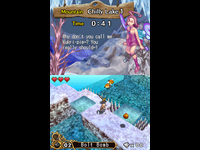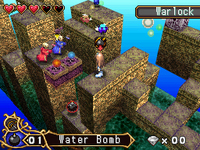|
|

|
PLATFORM
|
DS
|
BATTLE SYSTEM
|

|
INTERACTION
|

|
ORIGINALITY
|

|
STORY
|

|
MUSIC & SOUND
|

|
VISUALS
|

|
CHALLENGE
|
Unbalanced
|
COMPLETION TIME
|
Less than 20 Hours
|
|
OVERALL

|
- 'Rat in a maze' feeling when maps must be done one way
- Targeting and direction-finding are challenging thanks to perspective
- Terrible pacing
- Inconsistent AI
+ A few maps are fun to solve
|
Click here for scoring definitions
|
|
|
In the 1990's Climax was involved with a number of games that had interesting play concepts jammed into the then-popular isometric perspective. LandStalker, Lady Stalker, and Dark Savior all had points to recommend them but were also infuriating to play thanks to the challenges of seeing things onscreen. Climax's one effort that abandoned isometric view, Time Stalkers, somehow turned into the company's low point. This lineage of RPGs is doubtless the reason Steal Princess has merited coverage by RPGamer. Having failed to adopt the possibilities of newer technology, Climax uses an isometric view once more and has created an action-puzzle game that successfully recreates the feelings rodents in laboratory tests must experience when they receive electric shocks for not performing exactly as their observers wish.
Steal Princess's structure is very episodic. Anise, the protagonist, must go through a map searching for the key within it. This key is almost always obtained through the death of an enemy, and once obtained the key must be brought to a large lockbox. Inserting the key into the lockbox opens the exit, and once Anise departs the map is completed. Except for boss battles (of which there are exactly seven), all 150 mandatory maps in the game proceed according to this template. Later maps can be a bit longer, but it is possible to complete most of them in two minutes or less. Completing a map brings the player to several menu screens that must be clicked through before anything else can be done, which kills the pacing.
To complete each map, Anise must navigate its environs, which is not always such an easy task thanks to the isometric view. Veterans of the 16-bit console generation and Climax's past offerings in particular will remember how infuriating an isometric view for an action game is, and Steal Princess rekindles those memories. Judging Anise's distance from some object that she needs to land on is much more taxing thanks to this perspective, and it will result in falls. Falling does not equal instant game over, but the land she returns to is the last place she stood on that the game considers stable, and that may equate to a very long distance.
Anise starts every map with her whip. The whip is used to either pull Anise toward a target if she is airborne, or to pull the target toward her if she is on the ground. It can also toss enemies off of cliffs, but this does not count as 'defeat' and thus must be used very carefully. Anise can carry one other weapon at a time, and these weapons will be scattered within the map, to be located by the player. Swords, lances, maces, bombs, and shields can be used to dispatch enemies in this game. Some of these weapons can be used infinitely, and some have a specific number of uses before they break and disappear. There are elemental affinities at play, with enemies being vulnerable to different weapons that also have their own elements. Planning is vital when killing enemies for most maps, and a slight error in aim that wastes the one use of a certain weapon will often force a retry.
 Kukri-pie, as in a food that can be made with you for the main ingredient?
Kukri-pie, as in a food that can be made with you for the main ingredient?
|
|
After beating every boss, Anise gains another heart for her health bar. Enemy attacks do not increase in power as the game continues, so it is possible to shrug off barrages that would have been death earlier. As for money, most stages possess gems for Anise to grab. Taking a hit while carting a gem causes Anise to lose it. The only uses for money are to pay off Anise's debts and to buy parts with which maps can be made: Steal Princess has no items that can be bought.
The game is designed to encourage replay of its stages until speedy completion times are achieved with all of them. Upon completing a map, the time taken is displayed, and new records are announced with a flourish. Bronze, silver, and gold medals are awarded for completing maps within a certain time limit. If every map in a zone has been cleared with a medal, bonus maps open up for exploration. There is also the ability to design one's own maps using a few templates the game provides, should this seem enticing. Simply finishing the game could probably be done in twelve hours if one is particularly skilled at its style of play, but tinkering with the records can stretch the playtime out a great deal more. Also, a limit of around twenty hours is probably closer to how much time will actually be necessary for completion when so many maps require trial-and-error to solve.
In a strict sense, Steal Princess is not difficult because every map can be restarted at any time, even after a game over. If one has the patience to learn the order Climax intended a map to be solved using, it will be very easy. The game requires absolute adherence to the formula for far too many maps, however. When the game requires that enemies be killed in a certain order, it is very picky about that order, to the point that killing another enemy at the same time as the one next in line will force the stage to be retried. Some maps are easy to breeze through, others will require repeated attempts in an effort to figure out exactly what the solution is.
 Because Anise has no depth perception, you must go without it also.
Because Anise has no depth perception, you must go without it also.
|
|
The story in Steal Princess suffers from poor pacing and by not being very involving. The protagonist, Anise, fails in an attempt to rob a demon palace and wakes up with a king Sigmund watching over her in his kingdom. It seems his son Oliver has been kidnapped by demons, and given that Anise seems to be the Legendary Hero she gets the job of saving the prince. Conveniently enough, doing so will keep her out of jail for the thefts perpetrated by another woman named Anise throughout Sigmund's kingdom. Accompanying her on this journey is Kukri, a little fairy that served the hero of long ago and wants to serve this new one the same way. Once the introduction is accomplished, the plot only pops up sporadically for the rest of the game, and is moderately amusing thanks to Atlus but does not hold interest because the game's focus is not on story.
Steal Princess does not look bad, but it does look lazily developed. There are six areas in the game and each of the six recycle the same terrain repeatedly. The same enemies show up in every zone (except bosses), and sometimes Climax exacerbates the repetition by expanding the enemies to show off their pixelated sprites. The music is not a particularly varied lot with one track for each setting, but its high quality helps to alleviate this. Steal Princess has a lot of faults, but atonal music is not one of them. The tiny bits of voice acting are very repetitive and annoying, however.
Steal Princess's entire structure is antithetical to exploration and its mechanics are more often infuriating than not. Far too many of its maps can only be completed by following a plan that tolerates no deviation, and the result is akin to making players run through a laboratory maze with the reward of only another laboratory maze at the end. Some of the puzzles are interestingly designed and a few elements of the game are fitfully entertaining, but they are not enough to salvage a frustrating experience. Based on this game, Climax climaxed years ago.
Review Archives
|









